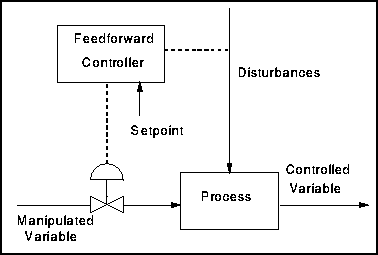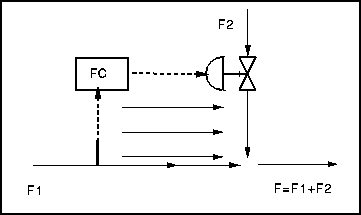In Feedforward Control configuration, a sensor or measuring device is used to directly measure the disturbance as it enters the process and the sensor transmits this information to the feedforward controller.
The feedforward controller determines the needed change in the manipulated variable, so that, when the effect of the disturbance is combined with the effect of the change in the manipulated variable, there will be no change in the controlled variable at all.
The controlled variable is always kept at its setpoint and hence disturbances have no efffect on the process. This perfect compensation is a difficult goal to obtain. It is , however, the objective for which feedforward control is structural.
Feedforward Control
A typical feedforward control loop is shown in the figure below.

Another name for feedforward control is open loop control. The reason is that the measured signal goes to the controller parallely to the process.
This can be seen in the next figure. This is in contrast to feedback or closed loop control.

As mentioned previously the main advantage of feedforward control is that it works to prevent errors from occuring and disturbances have no effect on the process at all. However, there are some significant difficulties.
Complex Computation
The feedforward control computation involves determining exactly how much change in manipulated variable is required for a specific change in disturbance.
To be able to make this computation accurately requires significant quantitative understanding of the process and its operation.
There is also a tremendous escalation of the theoretical know-how required in the feedforward controller’s computation activities.
Knowledge of Process
The structure of feed forward control assumes that
- The disturbances are known in advance.
- The disturbance will have sensors associated with them (measurable).
- There will not be significant unmeasured disturbances.
These limitations on the disturbances constrains the application of feedforward control, simply as most disturbances in the industrial processes are unpredictable and unmeasurable.
Limitations
In pure feedforward control, there is no monitoring on the controlled variable. If the controlled variable strays from its setpoint there is no corrective action to eliminate the error.
This makes pure feedforward control somewhat impractical and a rarity in typical process application.
Specific Controller Required
The feedforward controller must be specifically and uniquely designed for the one particular control application involved, because of the necessity of accurate and quantitative calculations.
It can be seen that feedforward control requires a significant increase in technical skills and capabilities. As a result, feedforward control of specific variables is limited to the most economically significant cases.
In practical industrial application, only few cases are handle with feedforward control. While the number of application is small, their importance is quite significant.